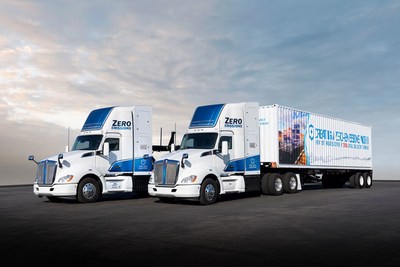First Heavy Duty Fuel Cell Electric Trucks Set for Delivery to Pilot Program Customers at Ports of L.A. and Long Beach
The first two fuel cell electric heavy-duty Class 8 trucks from the ZANZEFF project are set for delivery at the Ports of Los Angeles and Long Beach this month. Sponsored by the state of California, these trucks, powered by Toyota's fuel cell electric drivetrain, will be used for drayage operations. An additional eight trucks are scheduled for delivery in 2021. This project, part of a $41 million grant by the California Air Resources Board, aims to reduce greenhouse gas emissions and support the development of zero-emission freight technology.
- Launch of the first two fuel cell electric trucks demonstrates progress in zero-emissions technology.
- Additional eight trucks to be delivered in 2021, enhancing fleet capacity for sustainable operations.
- $41 million in funding from California supports development, showing strong governmental backing.
- None.
PLANO, Texas, Dec. 10, 2020 /PRNewswire/ -- The future of heavy-duty trucking will arrive at the Ports of Los Angeles and Long Beach this month. The first two fuel cell electric heavy duty Class 8 trucks built under the Zero and Near Zero Emissions Freight Forwarding (ZANZEFF) project sponsored by the state of CA are preparing for delivery to demonstration fleet customers.
Toyota Logistics Services and Southern Counties Express each will receive a Kenworth T680 Class 8 truck powered by a Toyota fuel cell electric drivetrain. Both of these zero-emissions trucks will be used for drayage operations in the ports of Los Angeles and Long Beach.
"We have been involved with Toyota's hydrogen truck project since the beginning and we are excited to see the latest models now being released for further testing," said Gordon Reimer, president, Southern Counties Express. "We are proud to be associated with the Toyota research and development team, and look forward to the continued progress of this technology."
An additional 8 trucks will be delivered in 2021 as part of the ZANZEFF program. Three of the eight trucks will go to United Parcel Service for its port operations while two of the eight trucks will go to Total Transportation Services, another prominent port operator. Toyota Logistics Services will also receive three additional trucks.
"After extensive testing with our proof-of-concept prototypes, we're ready for the next step of putting more trucks into drayage operations," said Andrew Lund, chief engineer, Toyota Research and Development. "Moving toward emissions-free trucks is more important than ever, and the ZANZEFF project has been instrumental in getting us closer to that goal."
Development of the Kenworth T680 FCEV is part of a
"The Port is currently engaged in 16 different zero-emission demonstration projects to support development of on-road trucks that we expect will help bring feasible zero-emission technology to the marketplace," said Chris Cannon, chief sustainability officer for the Port of Los Angeles. "Conversion of the Port drayage fleet to zero-emission technology involves tremendous financial investment and will take the collaboration and commitment of many stakeholders - both public and private - to create a viable market for zero-emissions drayage technology. We are proud of our continuing partnership under this project to deploy these trucks as an important step in verifying the capabilities and role of hydrogen fuel cell technology in the path to zero emissions."
TMNA R&D
Toyota Motor North America Research & Development (TMNA R&D) aims to redefine next-generation vehicles to more than simply a form of transportation. Since 2003, Toyota has been awarded more patents than any other automaker, including autonomous vehicle patents (more than 1,400). Centered in Ann Arbor, Michigan, Toyota TMNA R&D puts the brightest thinkers from across the globe together to focus on letting people live more safely and comfortably. Globally, Toyota spends approximately
Southern Counties Express
Southern Counties Express has been servicing the Ports of LA & LB for over 30 years. As an early adapter of many Compliance and Green Initiatives we are committed to continuous improvement in air quality.
California Climate Investments
The Zero and Near-Zero Emissions Freight Forwarding (ZANZEFF) project is part of California Climate Investments, a statewide initiative that puts billions of Cap-and-Trade dollars to work reducing greenhouse gas emissions, strengthening the economy, and improving public health and the environment — particularly in disadvantaged communities.
Port of Los Angeles
The Port of Los Angeles is one of the world's busiest seaports and leading gateway for international trade in the Western Hemisphere. It has ranked as the number one container port in the United States each year since 2000. The Port is a major economic driver at the local, regional, and national levels, and a key generator of jobs, commerce and tourism in Southern California. Located along 43 miles of waterfront, 25 miles south of downtown Los Angeles in San Pedro Bay, the Port encompasses 7,500 acres of land and water, and features both passenger and cargo terminals, including automobile, breakbulk, container, dry and liquid bulk, and warehouse facilities. The Port is strongly committed to developing innovative, sustainable operations that benefit the economy, environment, and quality of life for the communities it serves, focusing on supply chain efficiency, upgrading infrastructure, and transforming the LA Waterfront into a world-class visitor destination.
Media Contacts:
Ed Hellwig
469-292-1165
edward.hellwig@toyota.com
Brian Lyons
469-292-3573
brian.lyons@toyota.com
![]() View original content to download multimedia:http://www.prnewswire.com/news-releases/first-heavy-duty-fuel-cell-electric-trucks-set-for-delivery-to-pilot-program-customers-at-ports-of-la-and-long-beach-301190193.html
View original content to download multimedia:http://www.prnewswire.com/news-releases/first-heavy-duty-fuel-cell-electric-trucks-set-for-delivery-to-pilot-program-customers-at-ports-of-la-and-long-beach-301190193.html
SOURCE Toyota Motor North America
FAQ
What are the new fuel cell electric trucks being delivered at the Ports of LA and Long Beach?
When will the additional trucks from the ZANZEFF project be delivered?
How much funding has the ZANZEFF project received from California?
What is the primary purpose of the ZANZEFF project?









